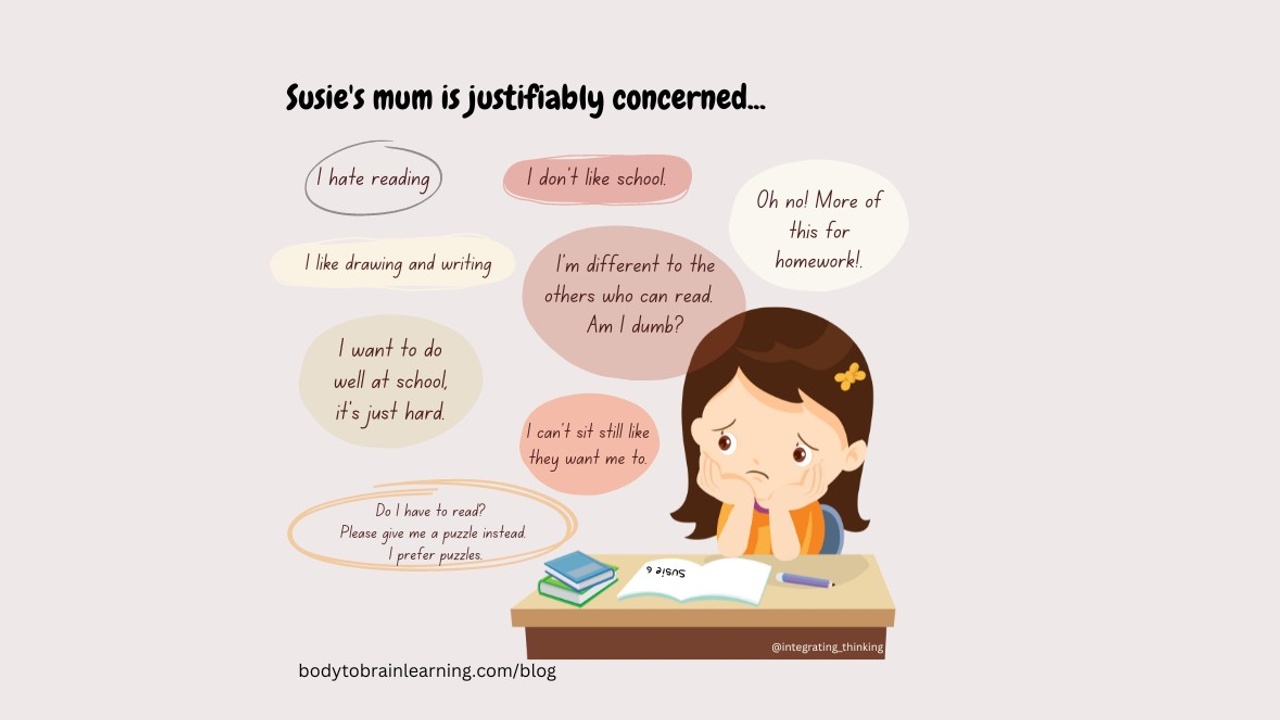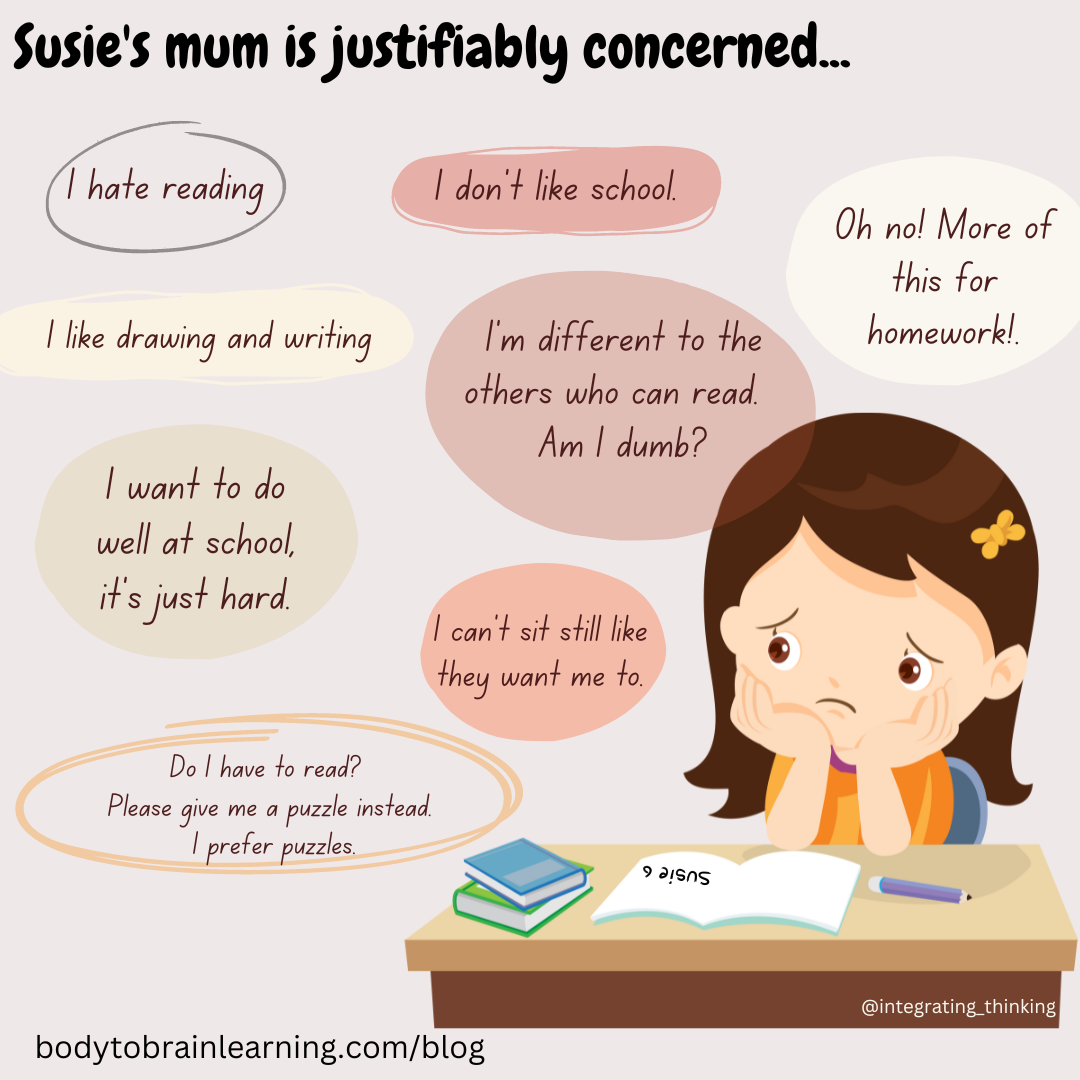Susie's Mum is Justifiably Concerned!
Sep 26, 2022
Last week, in my practice, I spent some time with a wonderful 6-year-old girl who is in Yr 1 and is struggling with learning to read and write.
Academically, Susie (not her real name), is falling behind her peers and she already dislikes the reading and writing requirements of her school learning experience. She’s in Yr 1, and there’s a lot more reading and writing going to be required of her in her time at school. She already feels different to her peers, knows she can’t achieve as well as them when it comes to reading, and she hates any reading tasks. So, Susie’s Mum is justifiably concerned.

Susie’s Mum describes Susie as being totally exhausted when she comes home from school. She hates homework, which means there’s a regular struggle in the afternoons. (Understandable when homework usually means more reading and writing practice.) Just before she turned six, Susie had already said to her mum that she was reluctant to participate in extra sports or after-school activities because she “needed to focus more on her schoolwork.”
Susie’s teachers are very aware of her reading difficulties and have “downgraded” her to Prep level reading classes and activities with which she is still struggling.
When I saw Susie for an initial assessment, she was shy, but also very interested in the puzzles I had and the activities we performed in the assessment. She warmed up and chatted openly about the activities we did and what they felt like for her. When it came to completing puzzles, she struggled with some of the irregular shapes in one of them. She took quite a bit of time to resolve the spatial manipulations required to make the puzzle pieces fit. But then she said, “Let’s do it again,” and completed the puzzle in less than 20 seconds the second time. She is a problem solver and is persistent. She learns quickly and appears to enjoy exploring new concepts.
When it came to copying a few words from a sentence in front of her, she eagerly participated and copied about seven words from the passage I gave her to copy. There were no spaces between the words she wrote and interestingly, the sentence she wrote made no sense. She had copied random words from random lines and joined them together. Copying for her was not a matter of reading, making sense of what she read and then transcribing the words; it was a direct replication of the word on which her eyes had landed. And, her eyes hadn’t landed in sequence from left to right on the same line. She had copied half of the first word in the first line, the first word of the third line, the second word on the second line, the fourth word of the first line, the sixth word of the first line, the first word of the second line and the fifth word of the first line. Her eyes had obviously jumped around, and she copied what she saw.
The temptation from a “teaching of reading” perspective is to say “well, she doesn’t have the concepts of print, especially the idea that we read from left to right and top to bottom.” Possibly, but that wasn’t apparent in the other activities we did. Instead, I suggest her ability to control her eye movements and accurately place where they land on a written sheet is compromised and random. This suggests there is an oculomotor challenge and what she produced in this copying test showed the results of what she may be seeing and experiencing when she tries to read.
Is it any wonder that she finds reading a challenge and tries to avoid it?
It's probably no surprise to those of you who know a bit about retained reflexes and oculomotor control to learn that she has a bundle of retained reflexes and some tricky and confusing oculomotor behaviours. She also has some static balance issues. All of these came out during our initial assessment. In particular, she has retained reflexes including an ATNR, STNR, and TLR, and she also has poorly developed Head Righting Reflexes. It’s probably safe to say her visual platform is a bit wonky! But, she’s active, she’s generally well-coordinated in her body movements, and she is great at riding bikes, outdoor activities, riding buggies and helping her Dad out in his mechanical workshop. She loves practical non-word / non-literacy-based activities.
Before I knew what I know now about retained primitive reflexes, balance and oculomotor control, I could have said: “Well, she’s a bright child who loves hands-on activities. She is a kinaesthetic learner and is a good problem solver. Hopefully, she will get better at reading and writing as she matures and, perhaps, we just need to keep giving her practice reading at her level (which is significantly younger than her peers) until she improves. Let’s work more on her phonics, her decoding and encoding abilities around letters and words.” “She needs more practice, so let’s keep giving her more opportunities to read and write.”
Oh dear! Poor Susie! “Give her more of what she is already really struggling to do in the hope it will make her better!” Hmm... let's think about that one! ... No wonder homework is a struggle and a problem for Mum and Susie.
When it came to reading aloud a simple sentence from a book in our assessment, Susie baulked and moved her head backwards, looked at her mother and shook her head. “I don’t want to.” She did read a few words for me, but she was incorrect with every word on the page. The picture cues which she looked at didn’t seem to give her much support in making up the story, but she tried.
Now, I know to look at the child’s body; to look at how Susie uses her body and how her body moves when her head changes position, and how regularly she changes position when seated. Her body tells me the foundations she requires for academic learning are not in place yet, and her body and brain learning systems are not mature enough to support the academic learning tasks of the Year 1 classroom, especially reading and writing tasks (top-level brain functions).
Susie’s story is not unique. It is, however, a good example of a child who struggles with learning to read, write, and perform academically at a young age. Fortunately, we can address the underlying neuromotor and sensory immaturity I’ve identified with Susie. We can help mature her body systems that support academic learning using a carefully constructed neurodevelopmental movement programme.
Thankfully, Susie’s mum wasn’t content with “She’ll grow out of it.” Thankfully, Susie’s mum took her for a vision check, and the optometrist who knows what I do in my practice suggested she see me. You see, Susie’s vision check didn’t throw up anything remarkable or out of place – her vision in standardised optometric testing was “average” for her age. She could, at that time and on that day, read the letters and meet the visual requirements of the testing regime the optometrist presented her. But, because he knew about the neurodevelopmental sequence and the likelihood of neuromotor and sensory immaturity, and he recognised some signs in her story, posture and behaviour, he suggested Susie should see me for a neurodevelopmental assessment.
It’s possible that, as we go through the process of maturing Susie’s neuromotor and sensory systems, she may need some vision therapy and possibly some glasses to support her vision system. But, using a neurodevelopmental sequence to address the underlying immaturity of her neuromotor and sensory systems first often brings the foundational systems for learning and function into line.
We use our bodies to learn, and our body systems need to be well developed to support upper brain level learning at school. Our brain develops from the bottom up, and developmental sequences help fine-tune and mature the processes that support higher brain function. If those aren’t in place, then activities like reading and writing can be arduous and awful. Susie’s behaviour and struggles were “yelling out for help”. She wasn't misbehaving. She was struggling. Thankfully her mum wanted to dig deeper and explore what was going on underneath the struggles Susie is experiencing at school.
I’m confident we will be able to mature her balance and primitive reflexes, and as a result, her oculomotor function will improve. I really look forward to the day when Susie can copy and write: “Four men and a jolly boy came out of the …” instead of “foseetheaboyofjolly”.
My guess is that change can happen quite quickly when we pay attention to the underlying foundations for learning and the neurodevelopmental challenges that she faces. She’s intelligent, motivated and creative, she just struggles to perform academically because her body isn’t cooperating with the processes required for the academic tasks of reading and writing. She's not neurodevelopmentally ready for those tasks.
I’ll keep you posted on her progress.
If you want to learn more about the INPP method, about exploring how the body tells us the learning story and learning experiences of the children and adults with whom you work, check out our “Body to Brain Learning” website, our Integrating Thinking website or the INPPAustralia website.
Bodytobrainlearning.com ; integratingthinking.com.au or inppaustralia.com.au
Understanding and applying the Body to Brain Learning™ process helps students and teachers attain better academic learning outcomes. It's a neurodevelopmental approach that impacts the well-being of students and teachers at school and can help support neurodivergent students and those who work with them. It also assists those who are underachieving academically and are experiencing learning challenges because of neuromotor and sensory immaturity.
LEARN MORE and STAY INFORMED
If you would like to learn more about the Body to Brain Learning™ process and join in the conversation, then sign up for regular updates, training information and other 'neuro-nerd' learning discussions using the button in the section below.
You can also follow us on Facebook, Instagram and Linked In. Please join in the conversation there. Body to Brain Learning™ is part of Integrating Thinking Neurodevelopmental Education Consultancy.
Dr Christine Payard (PhD) is a Neurodevelopmental Educator, founder of the "Body to Brain Learning™ Professional Development Series", Director of "Integrating Thinking" and the INPP Australia Principal.
She is an experienced teacher, presenter, and passionate educator who could talk all day about learning, how we learn, the body, the brain, and a functional and developmental approach to learning.
Learn more:
www.bodytobrainlearning.com www.integratingthinking.com.au www.inppaustralia.com.au
Stay connected with news and updates!
Join our "Integrating Thinking" and "Body to Brain Learning" mailing list to receive the latest news, updates & training information from us.
Don't worry, your information will not be shared with others.
We HATE spam, so you won't be inundated with emails from us.


